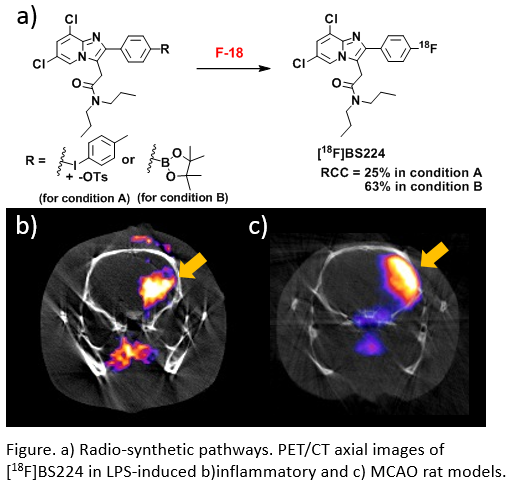|

|
| Type |
Oral Presentation |
| Area |
Oral Presentation of Young Discovery Chemists |
| Room No. |
Room 304 |
| Time |
THU 10:00-10:15 |
| Code |
MEDI.O-5 |
| Subject |
Synthesis and bioevaluation of a Novel TSPO-selective PET ligand ([18F]BS224) in Animal Models of Neuroinflammation and Stroke |
| Authors |
Sang Hee Lee, Jungmin Kim1, Byung Chul Lee2,*
Department of Transdisciplinary Studies, Graduate School of Convergence Science and Technology, Seoul National University, Suwon / Department of Nuclear Medicine, Seoul National University College of Medicine, Seoul National University Bundang Hospital, Korea
1Department of Nuclear Medicine, Seoul National University College of Medicine, Seoul National University Bundang Hospital, Korea
2Department of Nuclear Medicine, Seoul National University College of Medicine, Seoul National University Bundang Hospital, Seongnam / Center for Nanomolecular Imaging and Innovative Drug Development, Advanced Institutes of Convergence Technology, Korea
|
| Abstract |
|
Abnormal translocator protein 18 kDa (TSPO) expression in brain is markedly detected in activated microglia, choroid plexus, and reactive astrocytes [1]. The selective TSPO-binding ligand can provide a powerful imaging tool to detect and monitor inflammatory brain disorders, because TSPO expression is significantly lower in the normal brains [2]. Herein, we have designed an aromatic fluorine substituted imidazo[1,2-a]pyridine analogue, [18F]BS224 and presented its radio-synthesis and bioevaluation for PET imaging of neuroinflammation.
Aromatic [18F]fluorination of [18F]BS224 was conducted by two different precursors and conditions: i) diaryliodonium salts by using condition A; ii) pinacol boronate ester by using condition B [4]. Finally, aromatic [18F]fluorination of [18F]BS224 was successfully optimized by nucleophilic substitution of the pinacol boronate ester precursor using [18F]fluoride with copper catalysts. The results, together with those obtained on in vitro TSPO binding, stability, in vivo PET imaging studies with specific and selective binding for TSPO, and a clear visibility of inflammatory lesion in animal models support the conclusion that [18F]BS224 is a promising TSPO PET imaging agent for neuroinflammation.
Reference :
[1] B. Scatton, et al. (1987) Brain research, 421, 167-172.
[2] G. Kreutzberg, et al. (1997) Journal of neurocytology, 26, 77-82.
[3] K. Sang Eun, et al. (2011) Organic & biomolecular chemistry, 9, 8346-8355.
[4] V. Gouverneur, et al. (2014) Angewwandte chemie, 126, 7885-7889.
|

|
|
| E-mail |
kkpling@snu.ac.kr |
|
 123rd General Meeting of the KCS
123rd General Meeting of the KCS
 123rd General Meeting of the KCS
123rd General Meeting of the KCS